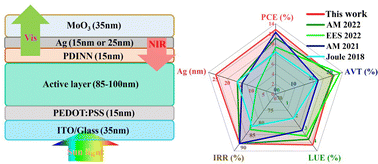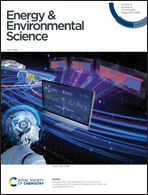Collaborative regulation strategy of donor and acceptor analogues realizes multifunctional semitransparent organic solar cells with excellent comprehensive performance†
Abstract
There are various see-saw effects between the performance parameters of multifunctional semitransparent organic solar cells (ST-OSCs), and hence how to balance all parameters to maximize the comprehensive performance is the biggest challenge in developing multi-functional ST-OSCs. In this work, for the first time, we propose a collaborative regulation strategy of donor and acceptor analogues to develop multi-functional ST-OSCs with highly comprehensive performance. Due to the strong morphology control ability and good complementary absorption favored by the collaborative regulation of the analogues, the addition of a donor analogue (DA) and an acceptor analogue (Y5) as the guest of the active layer not only boosts a higher power conversion efficiency (PCE), but also realizes the improvement of the average visible transmittance (AVT), color rendering index (CRI) and infrared rejection rate (IRR), minimizing the trade-off between these parameters. The collaborative regulation strategy demonstrates good effectiveness and universality in various active layers and device structures. The device based on DA:PCE10-2F/Y6:Y5 achieves a record efficiency of 15.57%, while the device based on DA:PM6:L8-BO:Y5 achieves an outstanding PCE of 19.09%. Notably, ST-OSCs based on DA:PCE10-2F/Y6:Y5 with 15 nm Ag achieve a LUE of up to 5.10%, a top value among the reported ST-OSCs, together with improved stability. The device with 25 nm Ag has a PCE of 12.95%, an AVT of 31.35% (yielding a LUE of 4.06%), an IRR of 90.3% and a CRI of 60.5, representing the best comprehensive performance of multifunctional ST-OSCs to date. ST-OSCs based on PM6:L8-BO with 25 nm Ag also have good comprehensive performance with an AVT of 20.02%, a PCE of 15.13% and an IRR of 90.1%. Our results demonstrate that collaborative regulation of donor and acceptor analogues is a facile and universal strategy to balance device parameters and improve the comprehensive performance of multifunctional ST-OSCs for practical applications.



 Please wait while we load your content...
Please wait while we load your content...